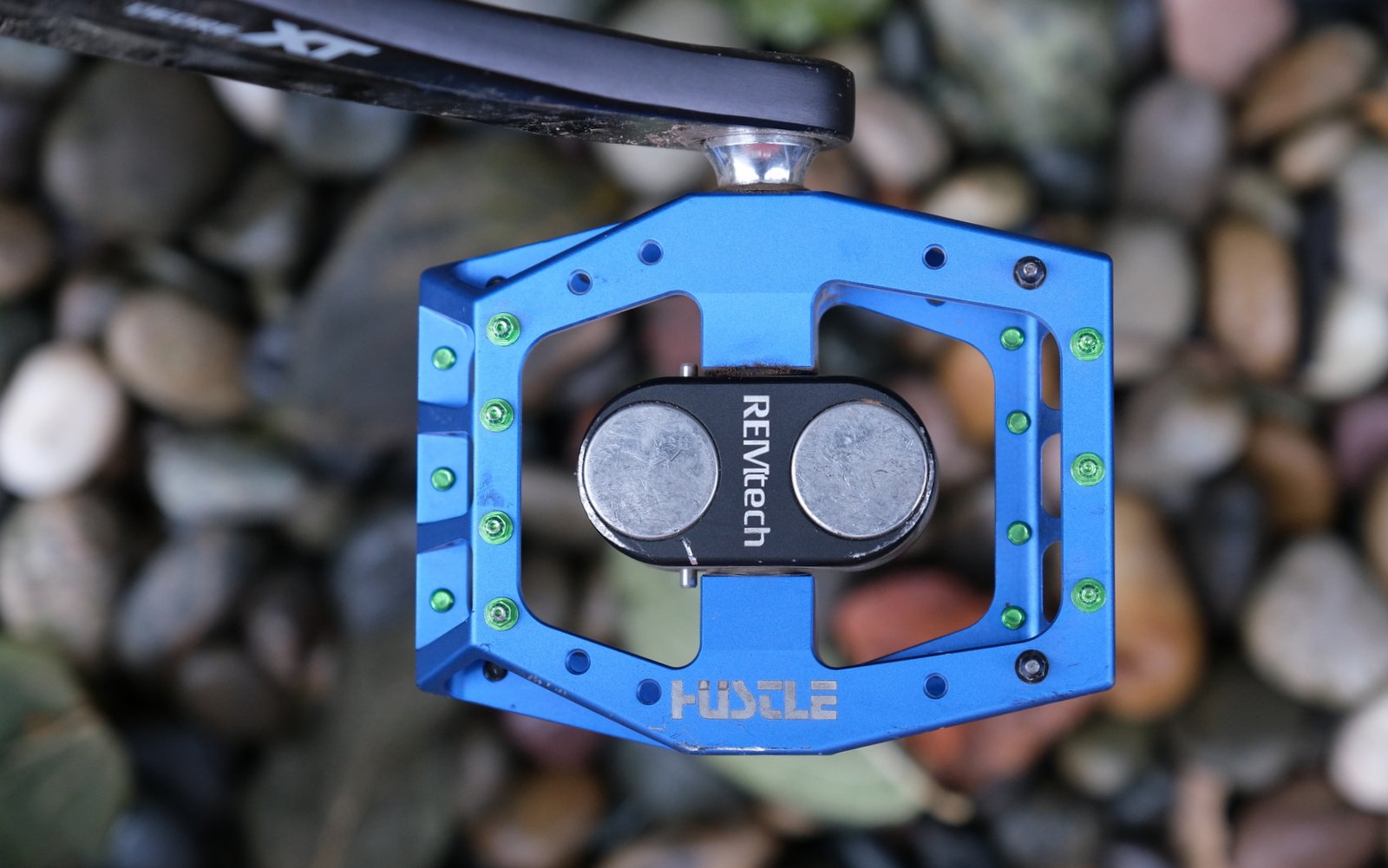
Review
Hustle Avery Remtech (Magnetic) Pedals
Cycling seems to draw many people that have solutions looking for problems. Occasionally, this top down method works out, and we see widespread adoption of things that we never would have thought that we needed. More often, things are introduced and then just slowly disappear.
It’s interesting to watch how this relates to trends developing in mountain biking. I think that you need to be a bit of a skeptic to be a mountain biker. It seldom pays to be the first person to jump on board something that is a bit crazy and weird. Once a critical mass is achieved though, adoption rapidly accelerates (whether it makes sense or not), and only once the masses are on board does the real refinement begin. This is the beauty of having well-heeled, vocal consumers.
Which is a pretty long way to introduce the review for what is basically a flat pedal with some magnets bolted to them. But I think we need to understand ourselves before we can begin to understand this product. Was I searching for a flat pedal with magnets bolted to them? Do I have a problem with the flat pedal system that I typically ride? Are there glaring deficiencies with existing clipless pedal systems? The answer to all of these questions is probably “no”. My initial reaction is to dismiss these pedals as a solution looking for a problem. But perhaps I’ve whiplashed enough times in recent years from “laughing skeptic” to “enthusiastic convert” that I’ve learned my lesson? Maybe there’s something to this idea?
I look at my decision process as to why I ride flat pedals. It was very conscious for me to become a flat pedal rider. I rode clipless pedals for many, many years. I specifically worked to develop my skills on flat pedals because I wanted to race dual slaloms and effective use of flat pedals seemed like an essential skill. Once I had those skills, I transitioned that over to the rest of my riding, and I haven’t really looked back.
That’s not to say that I can’t or don’t ride clipless pedals. Most of my commuter bikes are clipless, and every couple of years I’ll dust off a pair and slap them onto my mountain bike. The part that sends me back to flats is the cornering feel. This could be down to the particulars of my body (I have stiff ankle joints) but I feel like there’s a lot less that I can do with the bike through a corner when I’m clipped in. No amount of increased pedaling efficiency, or perceived security, is worth that trade off for me.
It would seem to me that this is a decision that every cyclist has made. You’re either a flat pedal rider or you’re a clipless rider and it’s not exactly clear that this is any sort of an issue. But reading between the lines of what I wrote above, there is a narrow window where something else could fit through. Maybe both of the current systems are a giant compromise and pedals with magnets are just what the world needs? Or maybe these things will give me less cornering feel than I like, but not strap me in with any sort of security either? Greater than the sum of the parts, or subtraction by addition? I guess we’ll find out.
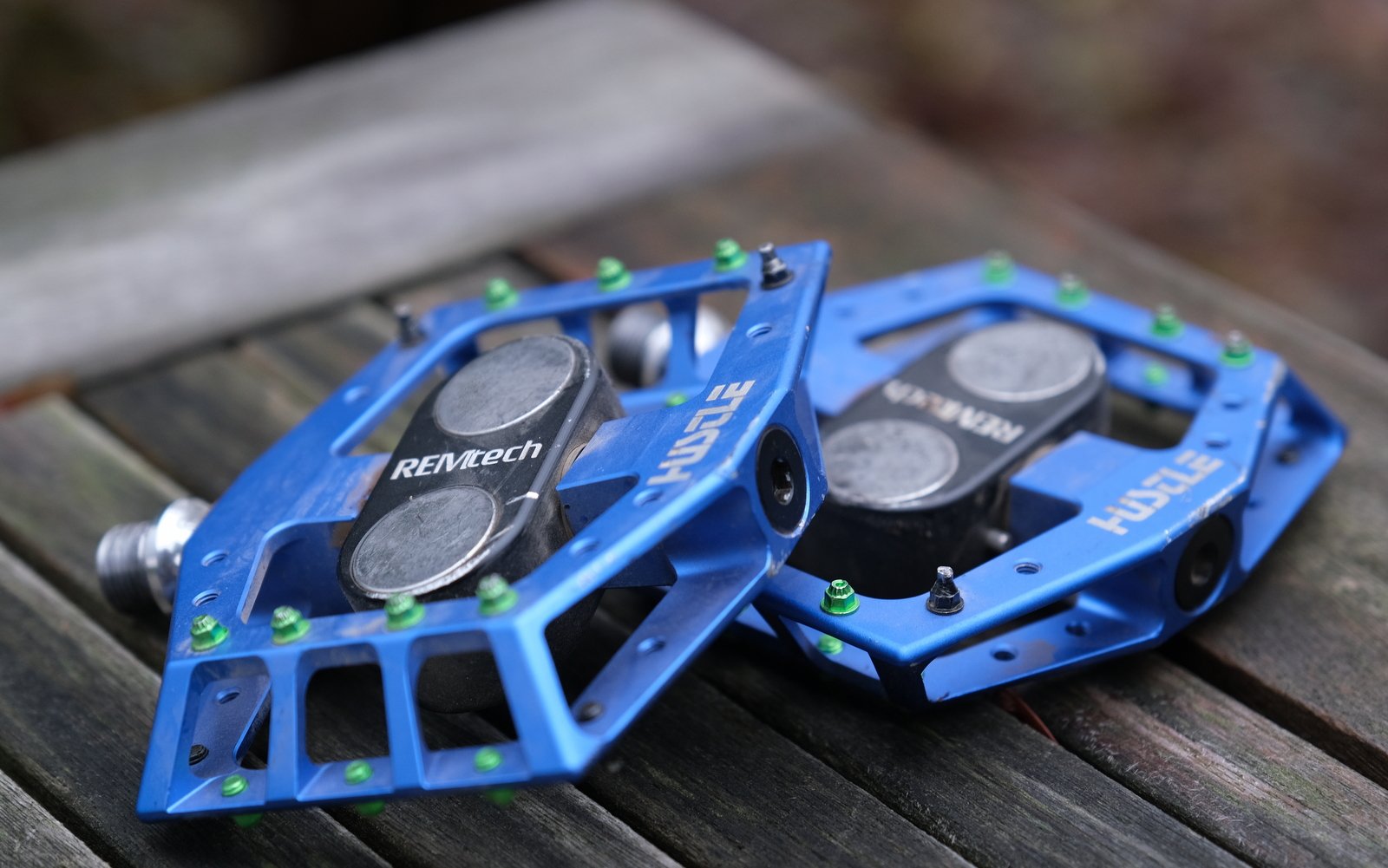
These are substantial pedals, by any measure. Fitting that magnet in the middle requires a bit of space.
Set-up
Pulling these things out of the box left me impressed. There’s some damning with faint praise here because when I first saw photos… Let’s just say that if these were regular flat pedals without magnets they wouldn’t have found their way onto my bicycle. I guess the need to jam a couple of fat magnets into the middle means Hustle can’t apply the lessons in thinness that we’ve learned over the last decade or so. But in person, they’re substantial and they look pretty okay.
There are also an impressive number of accoutrements contained in the box. The pedals come surrounded in cardboard, foam pads and warnings that are probably best heeded. It all seems a teensy bit silly, but the first time you get your hand caught between a shoe flying towards the pedal you’ll wish you paid attention.
The first thing you’ll want to do is attach the cleat/plate to your shoe. The cleat is gigantic and will fill much of the space, side-to-side, in your cleat box. This simplifies installation a bit, relative to clipless, as you don’t really need to worry as much about cleat angle or side-to-side location. It really comes down to fore-aft location and height. For me, I just lined it up with the centerline of the shoe, pushed it all the way back and I was good to go. Most shoes require the (included) spacer underneath, as well.
Once you move to the pedal, you’ll figure out that pin setup is really important. There’s a Youtube channel that you can check out that will walk you through pin set-up for several popular shoes. The gist is that you want the cleat to make contact with the magnets (center-to-center), and then you want the pins to close the gaps to the sole. This is mostly accomplished with the pins along the front and trailing edge, and can be a bit of a balancing act with all of the variables at play. The pedals ship with a buttload of extra pins in a couple of heights, so lots of adjustments are possible.
To get the proper setup, it took me about a half an hour of fiddling. I did a few iterations of attaching my shoe to the pedal, inspecting how things were lining up and then tweaking the pin heights and locations. This is the period where you need to really watch your hands, as the shoes move pretty quickly towards the pedal when they’re not attached to your feet. Once you have this all sorted out, you should be good to strap your shoes on and pedal around the block a few times.
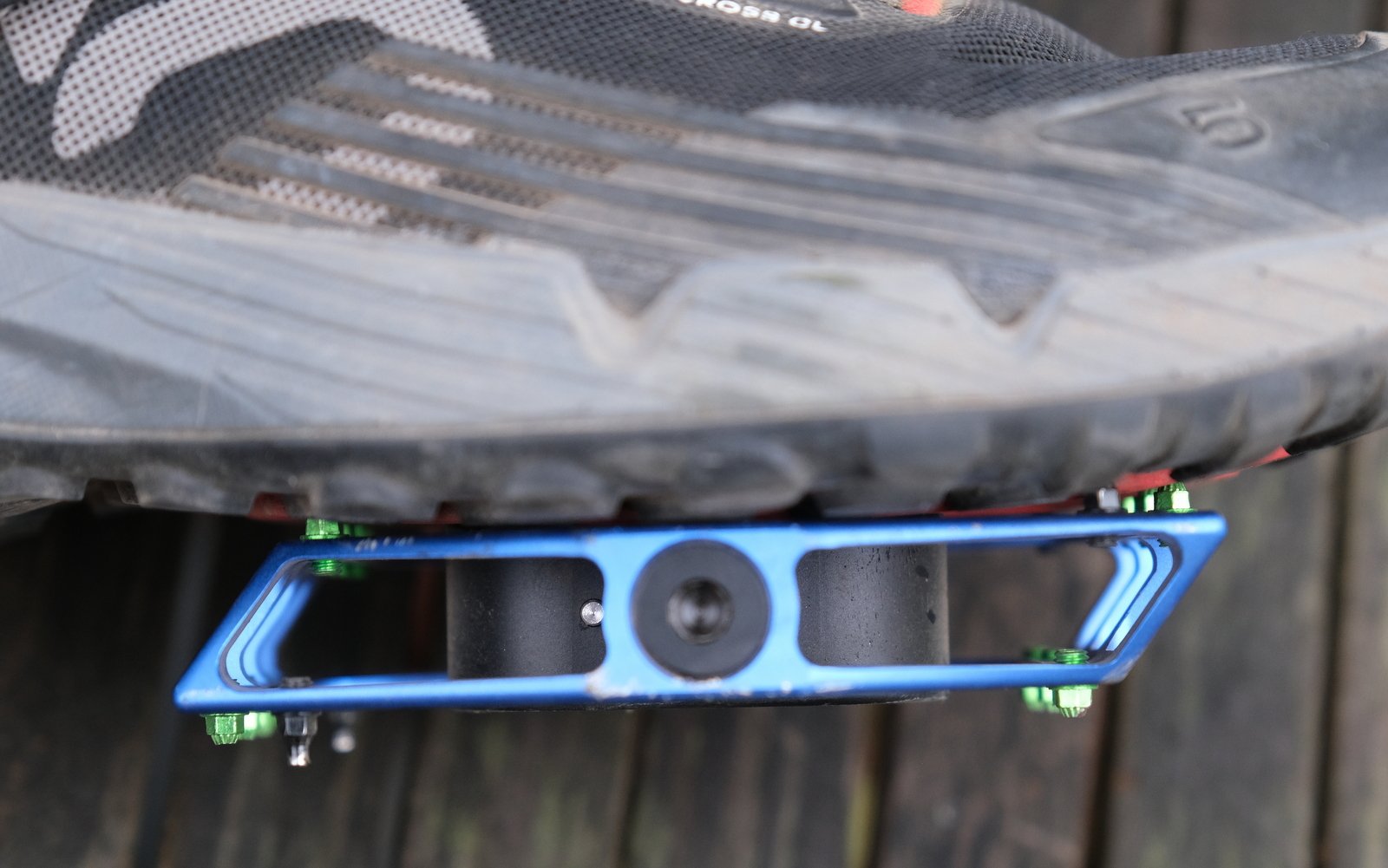
The goal is to fit the pins to the contour of the shoe. This usually requires a bit more meat up front than in the back
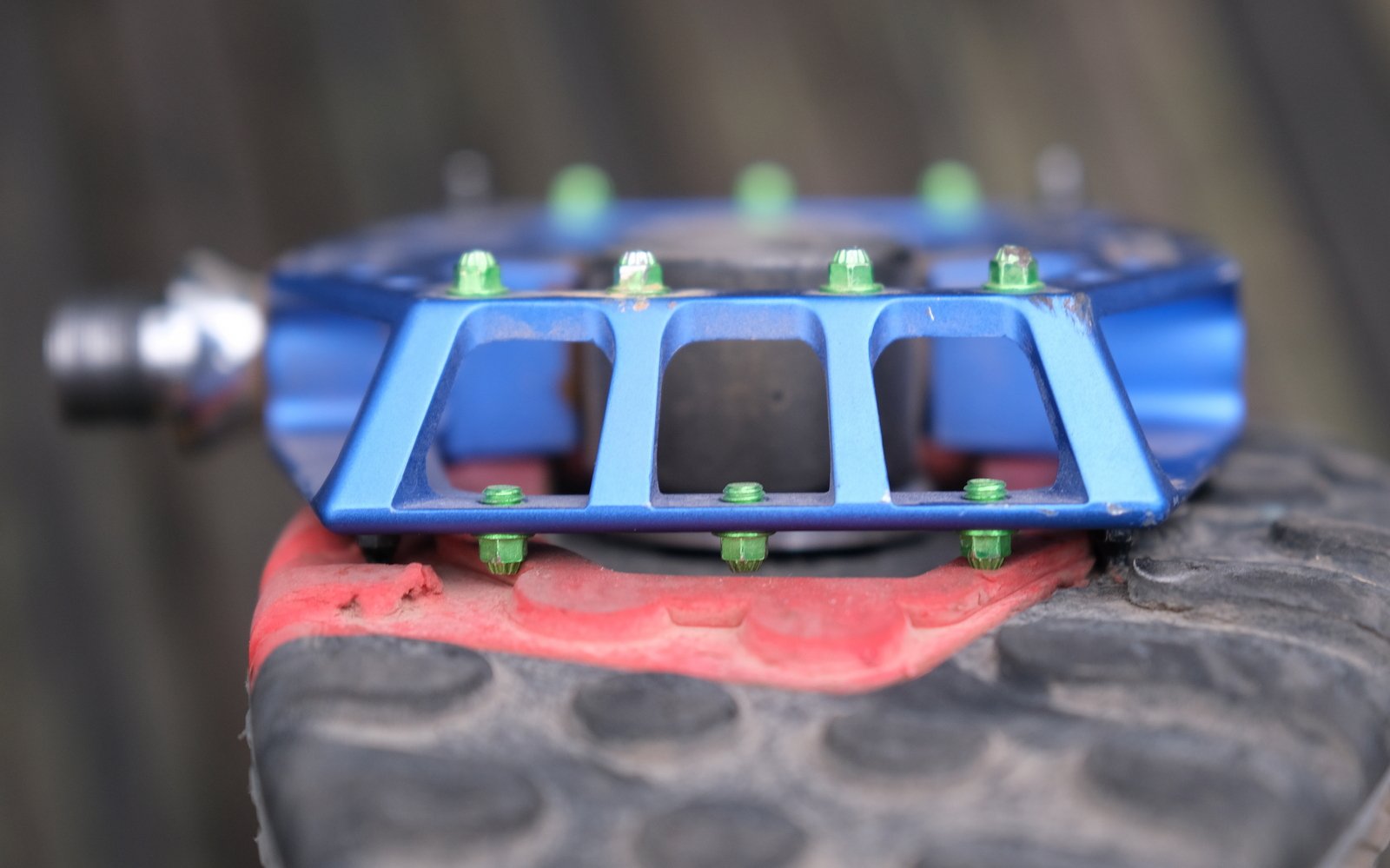
This setup worked well, with the two daggers at the front corner of the pedal. Interesting to note that the wear on my shoe suggests I spend some time riding with my foot too far back on the pedal.
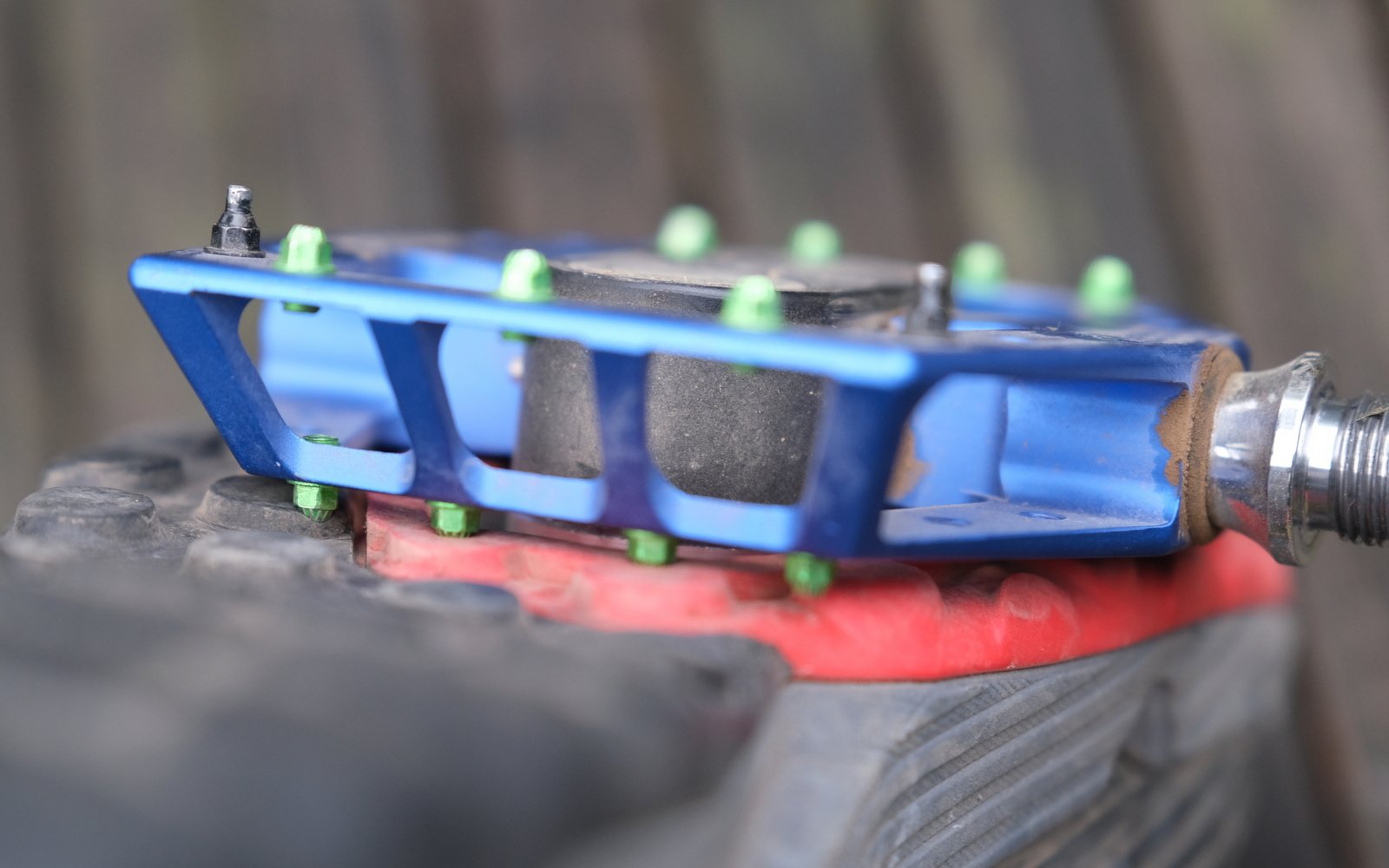
Nothing fancy required in the back. Just a row of the smaller pins.
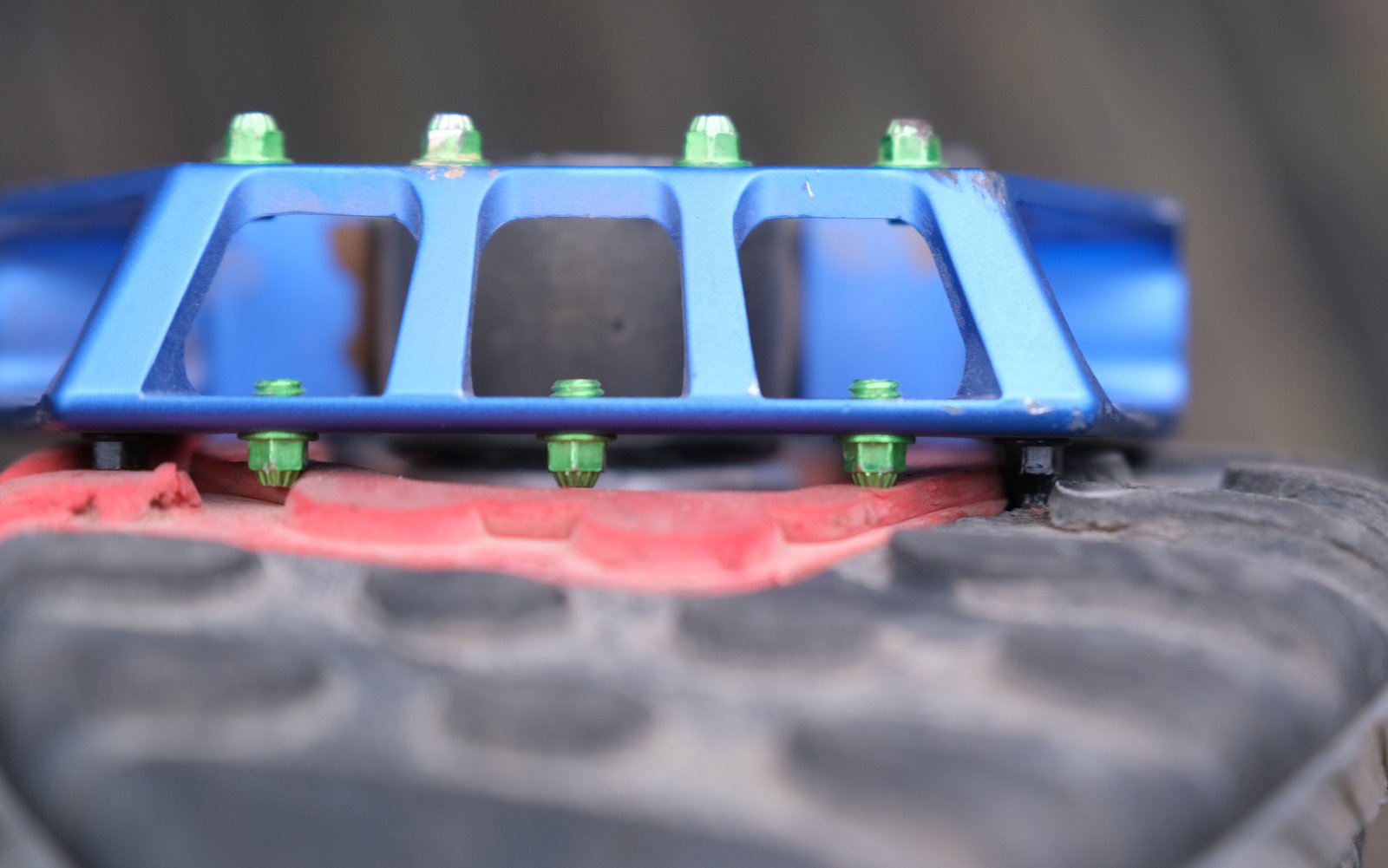
Another look at the front
Initial Experiences
The most surprising thing about these pedals is how often they surprise. The magnets lurk and make themselves known when you’re least expecting them. When you’re pulling them out of the toolbox that you’re storing them in…Bang! A staple gun falls on the floor. When you’re adjusting the pins…snap! The tool flies out of your hand. When your cleat clad shoe enters their vicinity…Kablamo! Your shoe snaps into place. Heck, I was just trying to wrestle my repair stand off the wall and it was stuck only to find it was stuck to my bicycle! These things are powerful.
The first lesson that this teaches is that you probably need to think about your foot placement more than you have in the past. Unlike with clipless pedals, it’s possible to attach in more than one configuration, and unlike with flats, it’s not easy to re-position your foot once attached. The pedal sucks you in, no matter how your foot is placed, once you enter a certain threshold. I found getting fore and aft placement to be the trickiest piece. Foot rotation is easy to control, and a bit of side-to-side variability wasn’t a problem, but proper fore-and-aft placement each and every time took a bit of experience. Again, the pedal pulls with so much force that there’s no hovering or subtle shifting of your foot once the pedal latches on.
I was really surprised by just how strong the pull is between magnets and cleats. You can pull straight up with a surprising amount of force and the shoe won’t release. Yes, you can probably pull up harder with a true clipless pedal, but these pedals will hold you in firmly enough to overcome any vertical forces you might put into them in normal riding situations. As well, unlike a clipless pedal, once you’re latched in, there’s no real float to speak of. Of course, this is dependent on pedal set-up. My first attempt with an old pair of rock-soled shoes resulted in a pivoting mess of float where it felt like I was skating on a steel plate. Perhaps there’s a middle ground possible where you maintain a bit of float, but it seems to me that this would defeat the purpose of these pedals. You need the pins to be biting into your shoe, and once things are set up to make this happen, you need to learn new techniques to adjust your foot. I found that a subtle roll of the foot was the best way to reposition, as this would break the connection enough that I could move around a bit.
At some point, you’ll want to remove your foot from the pedal. Any sort of twist or rolling motion is enough to allow you to pull your foot away. It shouldn’t take much for any clipless rider to adjust their typical movement to these pedals.
Inevitably, you will attempt to compare the feelings you are experiencing to that of either a flat pedal or a clipless pedal. You’ll determine that it is both, and it is neither. It is superior and it is worse. It is the same and it is different.
As you stand on the pedal, it feels like a flat. A really secure flat. Your foot is supported in all the right places. You’re in the pedal, you’re not on it. Or maybe you’re on it, not in it? Your foot is solid and it’s not going anywhere. But you don’t have quite the degrees of freedom that you have with a flat pedal. Where you once twisted and rolled, you’re now locked into a single plane.
As you pull up on the pedal, it is clipless. I don’t really have any expansion on that point. It locks you in with both more and less predictability. As I mentioned, depending on how you set it up, there’s no float! The magnets are pulling your shoes into the pins! But the release is also a lot different and, in certain ways, less predictable. Where the release point of a clipless is fairly obvious, here it can be less so. If you roll your foot it resists, resists, resists, and then it doesn’t.
This may sound daunting, but release isn’t really a problem. I find even when I’m getting off my flat pedals, years of muscle memory from clipless pedals means I do a subtle little ankle flick. This is more than enough to break the pull. That or a nice little roll off.
All of this is new. All of this is different. It is best if you try not to describe it based on concepts of yore.
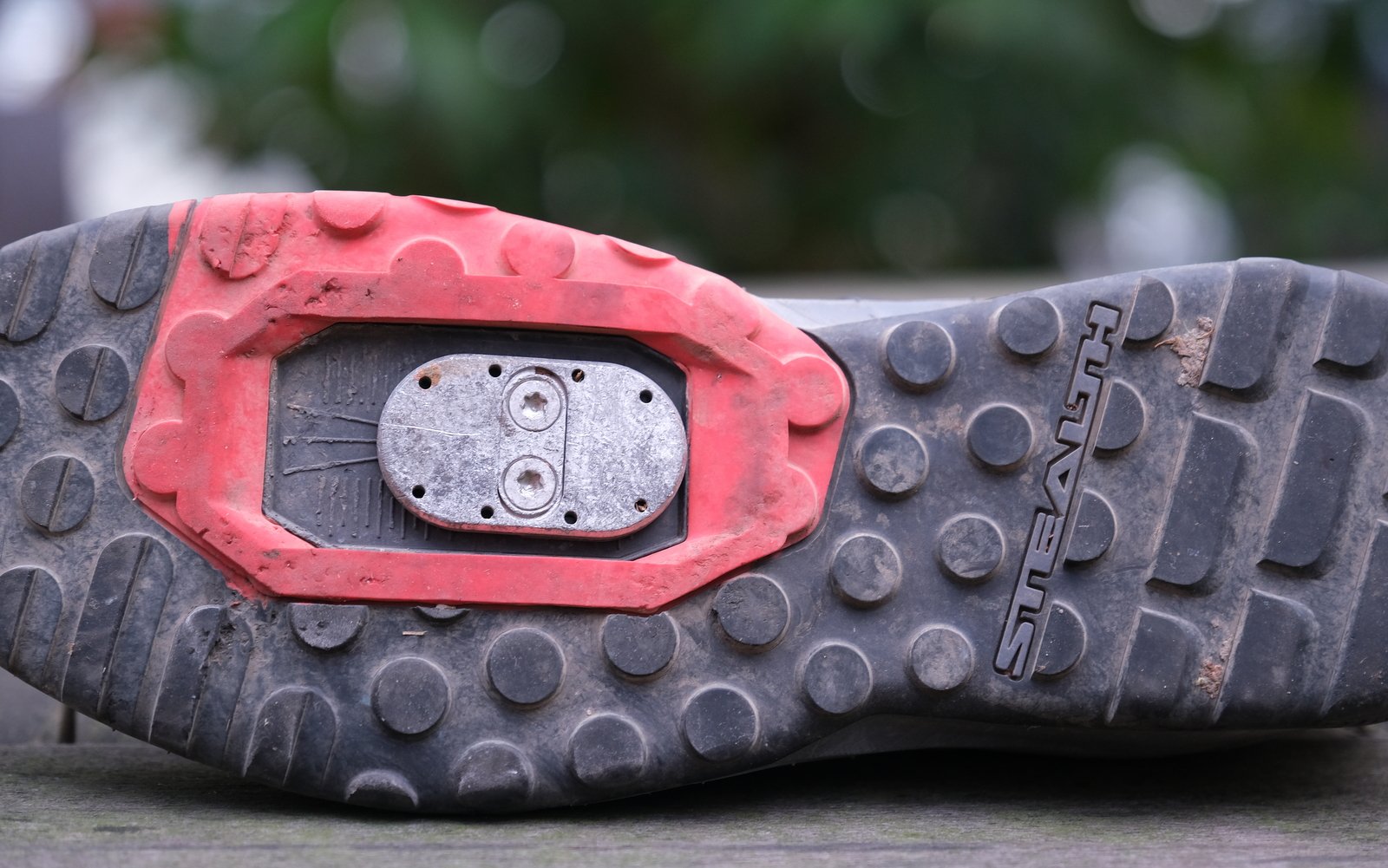
Jam it to the back and call it a day. The cleat itself is not magnetic.
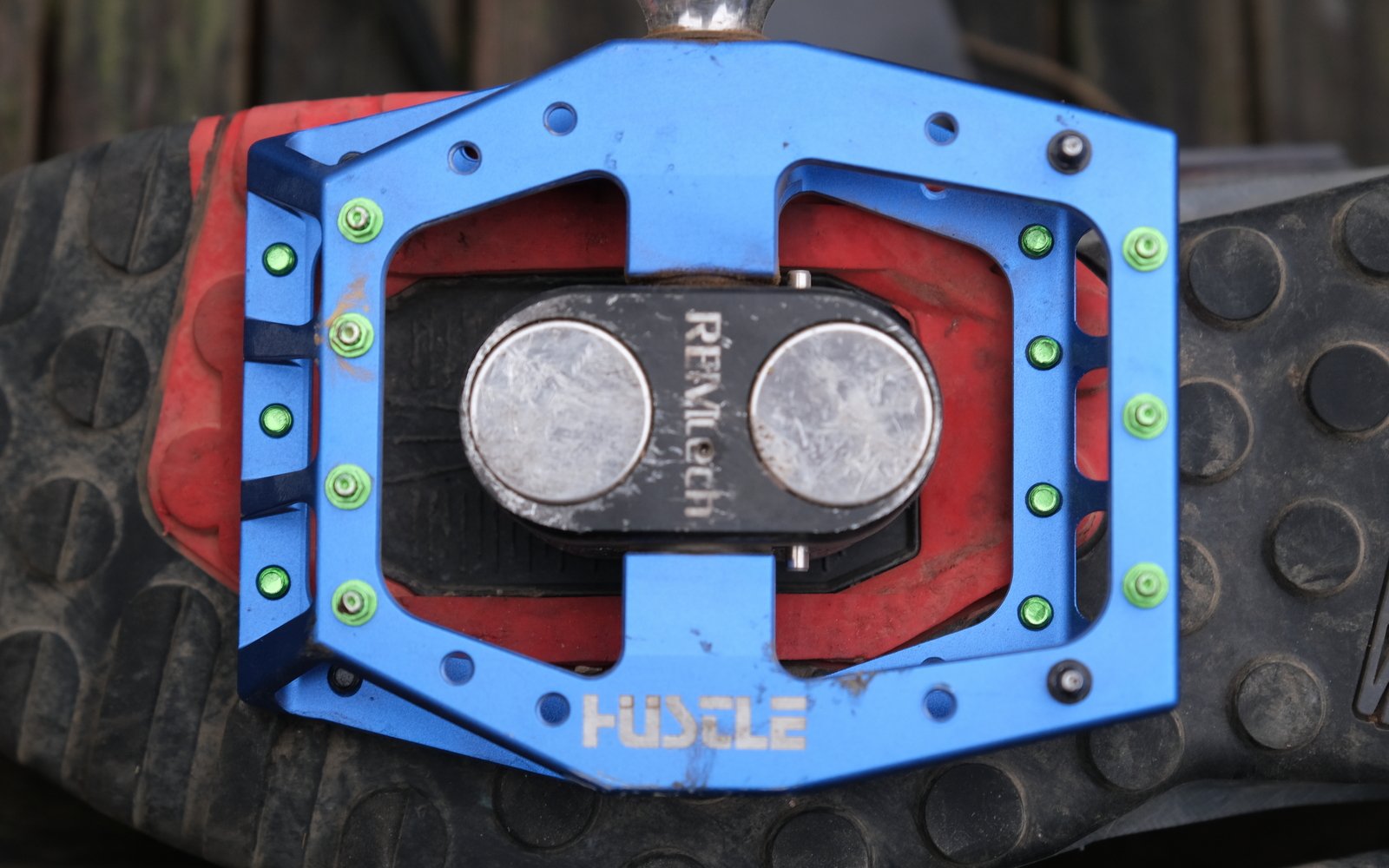
You want your cleat centered to the magnet, with full contact between the two. I would think that messing this up would substantially compromise the pulling force.
Long Term
I wound up putting a lot of riding time into these pedals. All told, I’d estimate several hundred kilometers. The vast majority of that was commuting and gravel-ish riding, with a bit of regular trail riding thrown into the mix.
The biggest standout for me is how great these pedals are for the act of pedaling. In that regard, they’re the best possible combination of clipless and flat. Like a flat, it really feels like you’re standing on something. Like a clipless, your foot isn’t going anywhere and you can really take advantage of pedaling all of the way around the circle. Please don’t “actually” me in the comments with an essay on pedaling dynamics. I just don’t care.
Retention on these things is great. I never came out of the pedal by pulling up. But then again, I’m mostly a flat pedal rider, so I’m not generally putting a lot of energy into pulling my feet up while I ride. Straight pulling force is great, but it doesn’t take much roll from your foot before the magnet significantly loses pull. I never had a problem while descending, but there were a few times where I put some heavy body English in while climbing and I popped out.
Riding down the trail, when all is lined up correctly, there’s nothing to worry about. Before these pedals I had thought that my cornering challenges with clipless were down to not enough freedom of movement. After riding with these, I think what I actually don’t like about clipless is all that float! I worried that having my foot sucked to the pedal was going to feel restrictive, but they really just feel like a grippy pair of flats. That is, when all is lined up correctly.
This is the major caveat that I have to these pedals. My entry ratio with clipless is as follows:
- 80% of the time – In with one smooth motion and a click.
- 15% of the time – Miss by a breathe on the first click so a subtle shimmy is required.
- 5% of the time – Oops. Stab at your pedal like a novice road biker.
Entry into a clipless pedal isn’t something that I think about, and I figured it would be the same with these pedals. The problem, though, is that they’re so hungry to grab onto that cleat, it’s actually fairly easy to attach to the pedal with your foot in the wrong spot, and if you happen to ride with your foot like that, the connection isn’t all that secure. As well, there isn’t much feedback when this happens. If you’re slightly off, it more or less feels the same as when you’re fully latched. With flats, you can feel where the pedal is under foot and with clips, there isn’t really an option to be in the wrong position. Not having either of those feedback mechanisms was a bit challenging for me, and as crazy as this sounds, these pedals are too easy to get into.
On easier trails or on asphalt/gravel, this wasn’t really a problem. Get one foot properly placed, and then you can usually have things lined up with only a quick glance at the other foot. On more complicated terrain, where you don’t have the luxury of taking a look or if your foot comes out mid trail, this can become a bit complicated.
I assume, like anything, this will improve over time and I would become just as confident getting into these pedals as I am now with clipless or flats. It didn’t come as quickly for me as expected though, and you should be prepared for a new learning experience, because it is different.
The advice that Hustle gave to help was to go with shorter pins to decrease the amount of bite – in essence dialing in a bit of float. I can see how this would help, as it would make it easier to realign if things are off. But part of what I liked was how solid everything felt, so I wasn’t sure if this would take me in the right direction. This does reinforce how much of the experience with these pedals is down to shoe choice and setup. If your sole is too stiff, I think you’re going to be too far away from the flat pedal experience. If your soles are too hard, they’re going to feel like a loose set of clipless pedals. The same thing if you get your pin setup wrong, or if you don’t set it up with full metal to metal contact between the cleat and the magnets. There are a tonne of variables, and a lot of different contact points. These will all impact your experience.
My shoe choice was the new Five Ten Trailcross CR shoe. For me, these were a really great balancing act. The soles are grippy and not too stiff, so they don’t feel all that dissimilar to a flat pedal shoe. As well, I was able to get them set up such that I had full metal to metal cleat/magnet contact, while having lots of good pin/sole contact as well. This gave me both lots of pulling force via the magnets and lots of grip via the pins. Again, different shoes might feel very different.
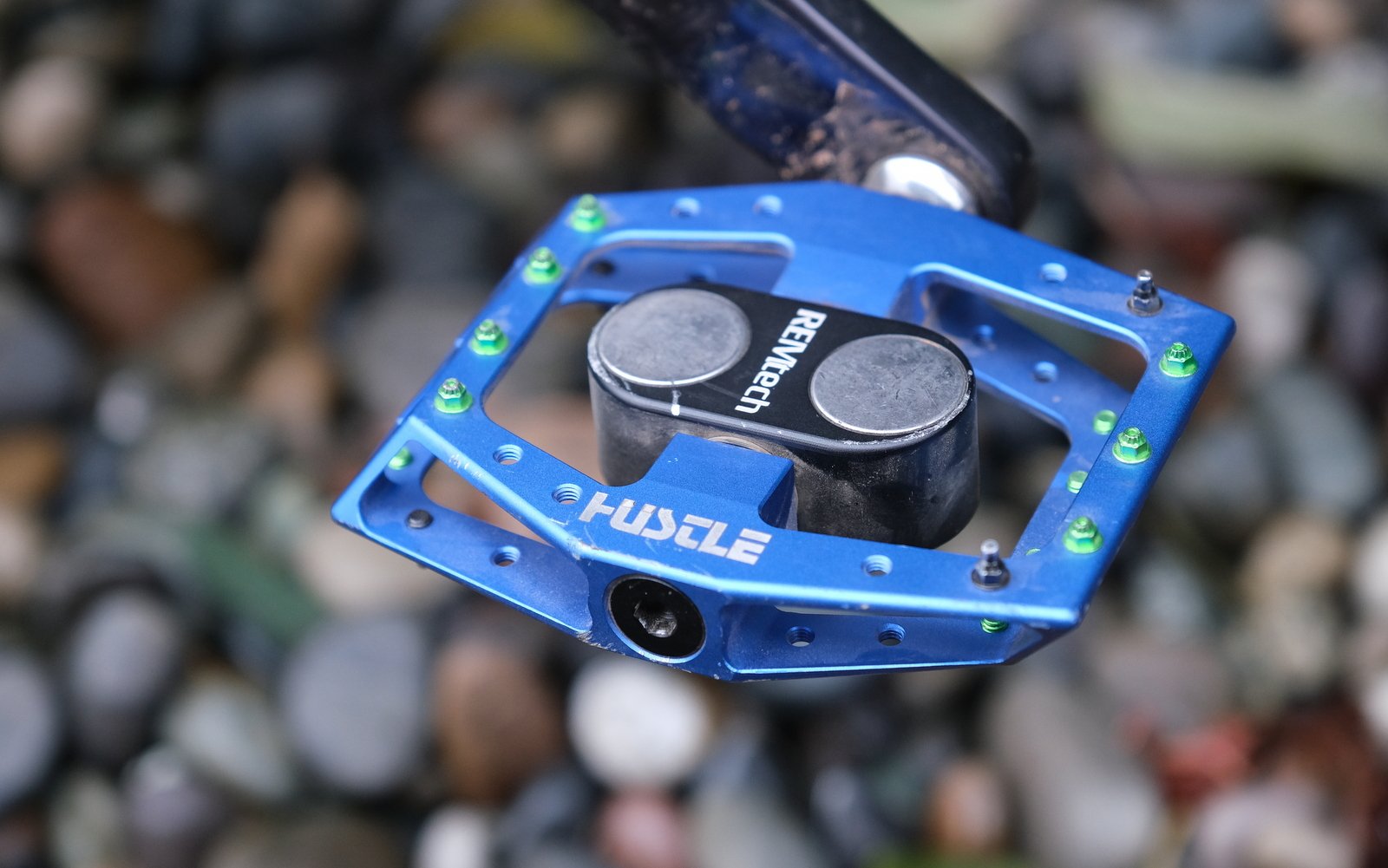
These are noticeable pedals, especially in bright blue. I had a couple of people loudly exclaim "Whoah! That dude's got magnets in his pedals!"
Back to Flats
Often, your best impression of a product comes either as you start to use it, or after you move to something else. I spent a month or so riding nothing but the Hustle pedal, and it was a bit surprising getting back to flats.
First, I was kind of shocked by how much my feet were bouncing around! Spending all of your time on flats you lose sight of just how disconnected your feet really are.
But I was also surprised by just how easy it was to put my foot in exactly the right spot, every time. Without even thinking about it, my foot would go to the correct place, which is honestly what I had expected of the Hustle pedal. I’m still trying to figure out exactly why I can put my foot right where it needs to be with a clipless pedal or with a flat pedal, but somehow can’t seem to get it exactly right once magnets are added into the mix.
In Conclusion
I really didn’t know what to expect out of these pedals, and I found them to be a pleasant surprise. I’m not at the point where I’m a full time convert for trail riding, as I really do like riding flat pedals. However, if I did feel the need to be more firmly attached, I would probably reach for these before I would reach for clipless.
All of my recent clipless experience is with SPDs, so maybe there are systems out there that would suit me better. After riding with these pedals though, every time I clip in to SPDs now it just feels kind of loose and awful. This was an interesting thing for me to wrap my head around.
Where I probably will consistently run these pedals is for all day rides or bikepacking type stuff. It may seem a bit counterintuitive to slap a big, heavy pedal on for this type of ride, but it’s sort of perfect for me. The comfortable shoes, slightly softer soles and walkability are my preference if I’m going to be riding all day, and these feel like the perfect compromise between clipless and flats for that type of riding.
I could see these pedals being a solution for many people. They really do give you the feel of a flat, with similar retention to clipless. There is a learning curve (that I’m still climbing after many, many rides) and they are heavy and expensive. Riding with these pedals didn’t make me miss flats, but it did make me realize what I don’t like about clipless pedals. The only thing really holding me back from being really, really into these pedals is the fact that I can’t quite get my foot placed exactly where I want it 100% of the time without looking or futzing.
Details
The Hustle pedal is available direct for US$219. The pedal body is 6061-T6 aluminum (with a 95x120mm footprint), and the axle is stainless steel. Claimed weight is 750g for a set, without pins installed and without factoring cleats (another 90g or so). Bearings are “sealed bearing/roller bearing sleeve” and I didn’t crack them open to have a look. Spare cleats are US$19 and spare pins are less than US$20 for a pack of 50.
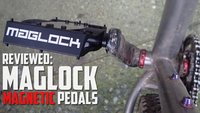
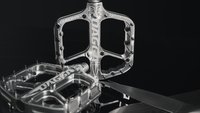
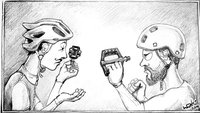
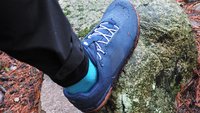
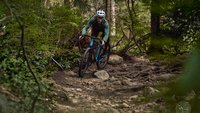
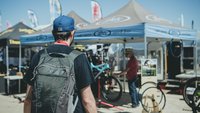


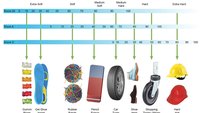
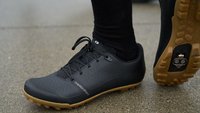
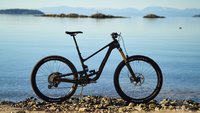
Comments
Andrew Major
1 year, 4 months ago
I think it’s worthwhile to note that an original motivation behind magnetic clip-in pedals, and the key reason to celebrate that there’s still development happening in this category, is folks riding with prosthetic legs.
The magnet holds the foot in place for pedaling but releases from any angle with minimal force so there’s no damage to the, often very expensive, limbs and the rider can separate from their bike.
AMPTbiking is worth giving a follow if you’re on Instagram.
.
I had the opportunity to review a pair of early production Maglock pedals in 2016. I think most folks will probably still be best off learning to ride flats or clips but it’s neat that companies are still working on the concept since this is indisputably the best interface option for some riders.
Reply
Dave Tolnai
1 year, 4 months ago
I'm bummed that the photos got torched from your Maglock review, but a quick google search turned up some images. Interesting to see a similar concept executed so differently. I think the rotating component of the Hustle really helps with retention. Would be curious to try the fixed Maglock.
Reply
Andrew Major
1 year, 4 months ago
It would be interesting to see the next-gen Maglock products. I assume they spin on proper cartridge bearings now.
These 'Toe Stops' add-ons they came up with are interesting. The cleat would still have float but it wouldn't have the drift that I experienced.
In any event, they aren't for me but I'm happy they exist and that companies are still putting energy into improving the idea.
I've installed a couple of pairs of MagPed pedals for folks at the shop. They're interesting in that they offer a range of magnet sizes (100N, 150N, 200N) as well as a 'strong' plate that's claimed to boost pulling force +30%.
Reply
BarryW
1 year, 4 months ago
I actually met a rider this year out on the trails who had made her own years ago along with her prosthetics guy. It was super cool talking with her and learning about how she had created it. A below the knee amputation.
She had not heard of MagPed before but was really interested.
A couple weeks later I met a guy in the parking lot with an above the knee amputation and used an SPD pedal but said he had occasionally had release issues. He also had not heard about MagPed and I'm pretty sure was going home to order some.
My wife who likes her flat pedals a lot has even expressed some interest in these as a 'safer' way to ride than fully clipped in.
Reply
kcy4130
1 year, 4 months ago
I'm going to design suction cup pedals.
Reply
RageingDH
1 year, 3 months ago
Electromagnetic with generator and battery packs built into the pedals with a Bluetooth controller on the bars to activate the pedals when your foot is perfectly placed.
Reply
papa44
1 year, 4 months ago
A great and thorough review, actually made me think rather than dismissing them out of hand which is a first. I’m still wondering though, how do they perform caked in mud and how many screws and nails have you come home with stuck to your pedals?
Reply
KavuRider
1 year, 4 months ago
I too am curious, wouldn't the magnets suck in any metal that you ride over? I can only imagine, riding on the street, how covered in metal bits these would be.
Great review!
Reply
Dave Tolnai
1 year, 4 months ago
I actually never picked up any metal while riding! And good question on the mud. I rode them this past weekend in the wet and there were no issues. It wasn't sloppy mud or anything, but I didn't even notice it. There isn't a lot of places for mud to get stuck on the cleat interface and it seems to just push out of the way. I should have included this in the review, but it was all ready to go by that point. Almost all my other riding was in the dry.
Reply
Velocipedestrian
1 year, 4 months ago
This makes me wonder what happens to the bearings and spindles as they wear. Does being magnetised accelerate wear? Reduce it?
Reply
Dave Tolnai
1 year, 3 months ago
I can't see this being the case. Electric motors have all sorts of magnetization and rotation and I've never heard of this causing an increase in wear.
Reply
BenLaden
1 year, 3 months ago
I wonder if it could affect the suspension of the bike negatively. I have them on my DH bike and havent noticed any suspension difference relative to my Catalyst pedals.
Reply
cxfahrer
1 year, 4 months ago
I wonder why those magnet plates don´t have a slightly conical shape - that would help finding the right position of the foot.
Reply
Justin White
1 year, 4 months ago
I think that's part of the selling points now: it doesn't have to line up perfectly. One of the commonly touted benefits of flats is that you're not locked into one single position like clips (with some float, sure, but really the pedals and cleats want you always in the same place). This seems to help reduce repetitive stress injuries.
Reply
Dave Tolnai
1 year, 4 months ago
I think there are a lot of things that could be experimented with to improve positioning. Shaped magnets or cleats? Smaller cleats? Larger magnets? Polarized magnets and magnetic cleats? I have no idea, but if they came up with something that increased the likelihood of my foot ending up in the same place every time, that would be a big improvement.
I could see how for some the lack of a fixed position would be a benefit. I do move my foot a little bit more forward when I descend on flats. But with these, I'd trade that for the ability to slap my foot into the max retention zone each and every time.
Reply
Justin White
1 year, 4 months ago
"The part that sends me back to flats is the cornering feel."
Hell yeah! Especially if, like me, the trails you have the easiest access to (out the front door) don't have much for elevation or obstacles but do have lots and lots of turns, flats is the way. Just so many options with how you can try silly fun stuff through those corners (and the random rock or log take-offs and buttress-root side-hits) if you're not clipped in. Dive in hot to the flat decreasing radius corner and let the front push a bit, twist your feet to move your hips more and find some traction, enjoy the catch and slingshot out. Take the inside line on the off-camber, throw a foot out and let the back get loose on the way out.
And yes, I know many people [claim they] can unclip and go foot-out-flat-out and clip back in without noticable delay, but I think it's more the subconscious knowing that it will take fractions of seconds longer and it will actually take some energy, both physical and nervous-system (even "muscle-memory" takes some nerve processing power). But the amount of tappy-tap-taps I hear out on the trail tells me most people can't or don't ever clip back in all that fast. That delay definitely affects line choice. Your brain doesn't want you to unclip and reclip, and so will just steer you towards the smoothest line least likely to cause anything. On flats you're more "free" to ride every corner however you feel, which minimizes the "boring trail" aspect (I honestly think that if you find an actual "trail" boring, you're the boring one).
Reply
Cr4w
1 year, 4 months ago
That was a really interesting review. I would really like to try these things.
Reply
John Keiffer
1 year, 4 months ago
They are pretty heavy. I think they would need some kind of demo program, allowing people to try before they buy in order to see if they offer the individual enough positives. I'd certainly like to try them, but I'll probably just bounce around on my flats without a demo option. I do like options. Oh and I like the big elongated platform even for size 44 shoes.
Reply
Dave Tolnai
1 year, 4 months ago
A demo program would be pretty cool. It is a large jump to make without trying it out. The only challenge I could see is that you really do need the right shoes, so that is another hurdle if you want to do demos. If you just slap the cleats into your regular clipless shoes, it may or may not work very well. the sole/pin interface is quite important.
Reply
Jimothy.benson
1 year, 4 months ago
From one flat pedal rider to another, you have this bit in there twice:
Retention on these things is great. I never came out of the pedal by pulling up. But then again, I’m mostly a flat pedal rider, so I’m not generally putting a lot of energy into pulling my feet up while I ride. Straight pulling force is great, but it doesn’t take much roll from your foot before the magnet significantly loses pull. I never had a problem while descending, but there were a few times where I put some heavy body English in while climbing I popped out.
Reply
Dave Tolnai
1 year, 4 months ago
Ya. There was some weird artifact from my cut/paste into the system. Fixed now!
Reply
Justin White
1 year, 4 months ago
I wonder if these might be a good stepping stone for someone moving away from a long time on clips towards flats. The magnets can help keep your foot connected through the top of the pedal stroke when powering through rough stuff (where I often notice people addicted to clips tend to get light on flats and end up rolling the pedal and having a slip and maybe a shinner or calf scrape), and give a little more confidence when going gets rough downhill, but still allowing slightly better/quicker/easier off & on than regular clips.
Reply
Raymond Epstein
1 year, 4 months ago
I love riding in flat pedals and this is after years of riding clipped in. I honestly see almost no downside. The one place where I could see these providing an added benefit would be having the ability if possible to pull up and through a janky ledge, rock, root on a climb which I cannot do with flats. Obviously doing so requires more gymnastic body English than I have acquired, but maybe these could help. I've yet to see anyone reference this scenario in reviews of these or other magnetic pedals. Any thoughts? I've plenty of time as these are sold out until next spring.
Reply
Dave Tolnai
1 year, 4 months ago
I just don't ride like that so I can't speak to it. I had another look at Matt Beer's review on Pinkbike today, and I think he talks about this scenario, but I could be wrong.
I'm sort of with you. I'm quite happy on flats and don't really have any challenges, but I was incredibly surprised by how detached I felt on my first ride back on flats. I adjusted pretty quickly, but it shows that there is a difference.
I found the whole thing to be an interesting thought experiment and I think others could benefit in exploring why they make the pedal choices that they do.
Reply
Please log in to leave a comment.